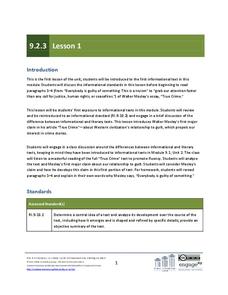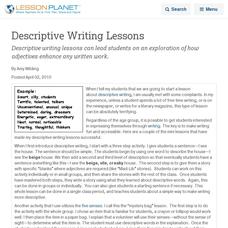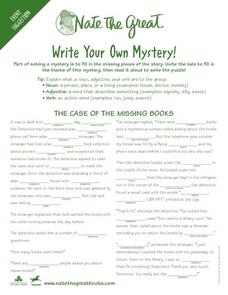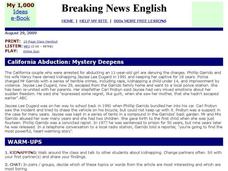Curated OER
The Purloined Letter
These questions about Poe's The Purloined Letter focus on publication and outside sources along with details of the story. Hopefully this story is not a mystery to you!
Curated OER
Genres, Genres Everywhere
Young readers assume the role of Genre Sleuths to investigate the characteristics of folktales, fantasies, and mysteries. For this session you will need to collect a variety of books on a topic you have been studying. Groups then examine...
Curated OER
Revising Your Mystery Story
Students edit and improve their short stories by examining character description, dialogue, and plot elements. In peer editing groups they correct gramatical and spelling errors. they read aloud their new story drafts.
Curated OER
House and Holmes: A Guide to Deductive and Inductive Reasoning
Test your pupils' reasoning skills with several activities and a quick mystery to solve. Learners watch and analyze a few video clips that demonstrate reasoning in action, practice deduction with an interactive and collaborative...
Curated OER
Classic Short Stories - Locked Room Settings
Young scholars read "The Problem of Cell 13" by Jacques Futrelle and explore the mystery genre. In this mystery genre activity, students read the short story and discuss the author's inclusion of locked room settings. Young scholars then...
Curated OER
Picture the Process!
Students read "Chasing Vermeer," and then study the author's writing process. They make connections between the book and the author's real life experiences. They then write an original mystery story, following the writing process.
EngageNY
Grade 9 ELA Module 2, Unit 3, Lesson 1
"True-crime stories, murder mysteries, up-to-the-minute online news reports, and (as always) rumor and innuendo grab our attention faster than any call for justice, human rights, or ceasefires." Or so says Walter Mosley in his Newsweek...
Purdue University
The Case of the Pilfered Pin: A Measurement Inquiry Activity
Who pilfered the pin? Scholars practice measurement skills as they solve the mystery of a stolen pin. They measure length, temperature, and mass and determine which of select suspects committed the crime. During the STEM hands-on...
Mary Pope Osborne, Classroom Adventures Program
The Backpack Travel Journals
Strap on those backpacks, it's time to travel through history with this literature unit based on the first four books of The Magic Tree House series. While reading through these fun stories, children create story maps, record...
Curated OER
Mad About Mysteries Book Report
In this literature learning exercise, students follow the directions to write a review of a mystery. They note the title, author, illustrator, and publisher before examining the characters and clues. They point out passage that show...
Curated OER
Picture the Process
Students read Chasing Vermeer and relate the book to the author . In this writing process lesson, students view Blue's Photo Album and see how the author writes and revises her work. Students discuss the process that all good...
Curated OER
Descriptive Writing Lessons
Descriptive writing lessons can lead students on an exploration of how adjectives enhance any written work.
Curated OER
Place Value Mystery Numbers
In this math activity, students read and solve 4 story problems in which they figure out the mystery number. The clues tell students about how digits are placed. Students write the mystery number as the answer.
Curated OER
A Study Guide for The Phantom of the Opera
Immerse yourself in the beautiful, twisted world of Andrew Lloyd Webber's The Phantom of the Opera. A detailed lesson plan provides important details about the writing, stagecraft, music, and literary elements of the famous musical,...
Curated OER
Nate the Great: Write Your Own Mystery
In this Nate the Great writing activity activity, students fill in the 26 blanks in "The Case of the Missing Book" with noun, adjective, and adverbs to create their own mystery.
Curated OER
Mystery Book Report Form Worksheet
In this mystery book report form worksheet, students complete a book report which includes the title and author. They write the names and descriptions of the characters, before the heart of the story, clues to solve of the mystery, and...
Curated OER
Main Idea
What could you pack for a trip if you don't know the destination? After writing a list of items they would want to bring, fourth graders learn that the "trip" is to the South Pole - revealing the need to understand all available...
Curated OER
Pizzazz!...Chain Stories
Students compose a short story working with partners. They create a beginning, middle, and an ending. Students brainstorm with their partners and create a creative short story.
Curated OER
Cuentos
Students revise Spanish mystery stories. They sequence the events from a group's mystery story and suggest revisions for the setting. They revise their stories using the suggestions from classmates and describe characters in folktales....
Curated OER
The Notorious Hope Diamond: What Makes an American Legend?
Students view and discuss a video on the legend of the Hope Diamond then compare and contrast other tales such as Paul Bunyan, Pecos Bill and Johnny Appleseed. They analyze basic characteristics of these legends then use descriptive...
Curated OER
Breaking News English: California Abduction
In this Jacee Lee Dugard worksheet, students read the article, answer true and false questions, complete synonym matching, complete phrase matching, complete a gap fill, answer short answer questions, answer discussion questions, write,...
McGraw Hill
Study Guide for Bridge to Terabithia
Bridge to Terabithia is a story about friendship that brings magic into ordinary life. Study guides may not be magical, but the guided questions, graphic organizers, extension activities, vocabulary, and discussion questions help...
Curated OER
A Map Mystery
Second graders solve a map mystery. In this technology lesson plan, 2nd graders develop an awareness of maps and the symbols associated with maps as they the "Neighborhood Map Machine."
Curated OER
Text Structures in Science Writing
Students recognize that science writing is organized in identifiable patterns called text structures. Understanding and using these different text structures help refine students' abilities to read and write in science.

























